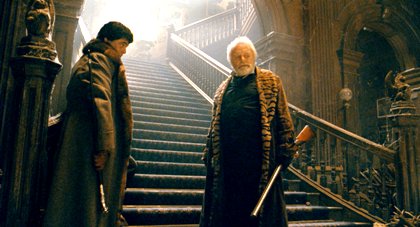Of the classic movie beasties, The Wolfman may be the darkest; without the well-meaning of Frankenstein’s monster or the finesse of Dracula, what’s left is a stripped-down metaphor for the untamable spree-murderer in us all. It’s a compelling archetype; however, it’s a compelling archetype that’s trickier to film than an aquiline gent with glue-on fangs who woos ladies until dawn. This is partly because of the effects involved, and partly because it’s tough to woo a lady when your main move is ripping out entrails.
In the past, movie depictions of the wolfman have been hampered by cheesy effects, ham-handed morality, and over-the-top acting. Thank heaven this year’s adaptation is directed by Joe Johnston (Jurassic Park III) and stars Benicio Del Toro and Anthony Hopkins; we’re going to be just fine!
As our movie opens, famous and skilled stage actor Lawrence Talbot (Benicio Del Toro) (no, really) is called upon by his brother’s fiancée to return to the family homestead, from which he is estranged because of tense relations with his father, and solve the mystery of his brother’s disappearance three weeks prior.
That this setup happens in a thirty-second montage while a letter is read aloud is the first sign that we are probably not in for a nuanced study of the feral subconscious within Victorian social mores. The second sign is Anthony Hopkins at the top of a flight of stairs, wearing the expression he gets whenever someone has paid him a great deal of money to be in a terrible film.
Lawrence finds himself stumbling through an increasingly nonsensical series of twists, turns, and condemnations of the Victorian medical profession as he attempts to discover the nature of the beast running through the woods, and the lingering secrets of his childhood. (If you don’t think these two things are related, you have never seen a movie before.)
It’s the sort of horror movie in which director Joe Johnston repeatedly uses the ‘long hush-loud surprise-immediate second loud surprise’ pattern, possibly in an attempt to keep his audience awake (with the dialogue he gives his actors, it’s a valid concern). It’s also the sort of horror movie in which everyone’s problems could be solved if anyone, at any point, divulged any sort of information to anyone else. At one point, Emily Blunt’s Gwen is researching Lawrence’s affliction; one chapter heading is “Lycanthropy,” and the next is “Ancient Gypsy Lore.” She still manages not to discover anything, which is just about the way this whole film goes.
There are fleeting glimpses of high camp; reliably, these moments include Anthony Hopkins. Benicio Del Toro is miscast and adrift; Emily Blunt has nothing to do (so much so that we never see a single frame of her with Lawrence’s departed brother Ben, nor do we have any idea who she is until we see her in an antique shop and have to take it on faith that she works there and she’s not just casing the joint). On the other hand, ingénues are required to be wistfully dull. More surprising is Hugo Weaving, who can generally be counted on to camp so high you have to look up through binoculars, but who is here so ineffectual as to be rendered unnecessary. (Uncle Hugo, say it ain’t so!)
Director Joe Johnston took many of his style cues from the 1941 George Waggner classic. The rest he took from Tim Burton’s Sleepy Hollow; we’re treated to numerous shots of grimy, suspicious townspeople, artfully-lit slaughterhouses-slash-morgues, and crumbling manor houses.
Unfortunately, the combination of new and old never gels, and the computer effects and matte paintings look equally out of place. Johnston attempts to update the aesthetic and introduce narrative tension by increasing the gore. However, though he lovingly details each wolf attack with lingering close-ups of entrails and bulging eyeballs and detached arms pinwheeling through the air, the CGI man-to-wolf transformations are drawn out to no great effect, and the wolf makeup used for close-ups is less an homage to Lon Chaney than it is evidence that it’s difficult to create a lycanthrope that doesn’t look like Teen Wolf.
The kitchen-sink approach extends to the themes of the film. The ham-handed gang is all here: manor vs. village, superstition vs. science, daddy issues like you would not even believe. Johnston updates 1941’s undertones by emphasizing the psychological horror (and the horror of Victorian psychology), and by making socially-progressive plot tweaks such as removing Roma as the cause of all the trouble and instead making them magical and unhelpful. Upgrade! (Not an upgrade.)
Unfortunately, by this point, we’re just rearranging dining chairs in a burning manor house. The Wolfman goes on to the end just as it began: trapped in a zero-visibility computerized fog of its own making.
Genevieve isn’t angry with Hugo Weaving, just disappointed. She writes about other bad movies on her blog.










